
REPORT 20 21
SUSTAINABILITY

SURPASSING
SEEBERGER
OURSELVES OUT OF LOVE FOR PEOPLE AND NATURE.
4 06 12 08 FOREWORD NATURWELT –OUR SUSTAINABILITY STRATEGY OUR COMPANY SEEBERGER CORPORATE GROUP AT A GLANCE 10 09 TRADITION & FUTURE CONTENTS
5 16|17 82 80|81 FOUR ACTION FIELDS GRI INDEX CONTACT & IMPRINT CIRCULAR ECONOMY 40 18 SUPPLY CHAIN RESPONSIBILITY 56 CLIMATE PROTECTION 68 COMMUNITY
Dear reader,
This Sustainability Report covers a period when we had to “surpass ourselves”. The Covid pandemic changed our working life at high speed. Usual processes? They had to be thrown away overnight. Every employee was affec ted, from the plantations where our produce is grown to the individual workstations at our Seeberger locations.
We have transformed our places of work, moving out of offices to work from home. We have altered wor king hours, changed our communication, drawn up and followed rules for video conferencing, abandoning our usual habits and routines. We have found solutions to a previously unknown challenge in the shortest time.
Together we have mastered this crisis. It was not easy – it took a lot of effort. It was possible because each and every one of us has shown a unique dedication. Accordingly, we would like to express our heartfelt thanks once again to all “Seebergerites”.
You see it every day: climate change is affecting the Earth. We are seeing it too, with record-hot summer days, droughts across whole swathes of farmland and fields and dangerously dry forests. What can we do?
You may remember: we made a promise in our last Sus tainability Report. It is on a lot of our packaging: “For a better planet”. In the report we also described how we would honour this promise. Our customers not only expect “a piece of nature” of the best quality in every Seeberger packet – but more.
Seeberger products are products from nature. We are responsible for preserving the fertile earth in which they grow. Our philosophy requires us to handle re sources in the source countries in a way that will enable many generations to come to harvest premium natural products there.
OUR PROMISE »FOR A BETTER PLANET«
During the Covid pandemic we learnt that we can sur pass ourselves. But it also slowed us down. With regard to key sustainability issues for the Seeberger supply chain, for example, because we were not able to tra vel to our supply partners in the source countries. For a common understanding of sustainability, however, not hing beats face-to-face conversations on the ground.
SUSTAINABLE PACKAGING? FOR US A QUESTION OF RESEARCH
We have managed to honour much of our promise: more and more Seeberger packaging bears our logo “For a better planet” with protective hands around the leaf and globe. We are reducing packaging material and changing its composition to increase recyclability. And we are researching alternative, sustainable packaging solutions with exciting partnership projects like the “HolyGrail Initiative”. Our goal is the perfect circular economy. Ambitious? Definitely. Read more in our “Cir cular Economy” section (from page 18). The impact of climate change is becoming ever more noticeable. So it is all the more important that we have been able to re duce our relative emissions. There is more information in the “Climate Protection” section (from page 56).
6
FOREWORD
We say: Sustainability is deep rooted at Seeberger – and has been for more than 175 years. Our supply chains today are highly complex and more fragile, while the demands of our customers are growing. And that’s a good thing! Because of course we want to meet these demands and grow as a result.
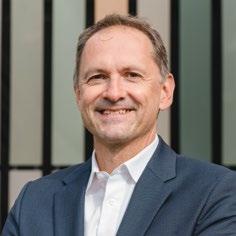


Alongside high expectations of our product quality, cus tomers want to know that they are produced in compli ance with human rights and environmental protection. These are conditions that we have agreed with our sup pliers a long time ago. Nevertheless, concrete imple mentation of all open tasks needed to fulfil the German Supply Chain Due Diligence Act (LkSG) is right at the top of our agenda.
Although we are not affected by the LkSG because of the size of our company, we want to fulfil these conditions in full. We are already well on the way. The “Supply Chain Responsibility” section outlines how we are approaching the remaining tasks (from page 40).
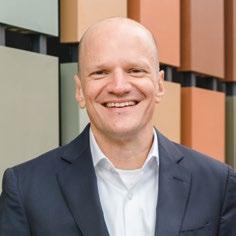
The “Community” section (from page 68) explains how we have initiated a cultural change to address the posi tive impetus for modern and attractive work environ ments as a result of the Covid pandemic.
WE ARE A STRONG COMMUNITY
We have also gained many new colleagues in recent years through company acquisitions. We also report on how we have started the structural process to create a new Seeberger community culture.
What motivates and emboldens us? Megatrends like healthy and sustainable eating are now centre stage in society, precisely because of the pandemic. We can see it in our sales figures: people want high-quality, healthy food that they can trust: our natural products! We want to continue to live up to this trust. That doesn’t just apply to our customers by the way. It also goes for our many “Seebergerites”, who are the ones who make our great products possible at all locations and in all the supplier countries.
To do this, we will continue to rely on courage, motiva tion and our strong Seeberger community.
We hope you enjoy the read, Clemens Keller, Ralph Beranek, Raphael Steinberg, Gerald Lindinger
7
NOT ACTUALLY A CHALLENGE FOR US: THE GERMAN SUPPLY CHAIN DUE DILIGENCE ACT
RALPH BERANEK
GERALD LINDINGER
RAPHAEL STEINBERG
For a be t te r planet!
CLEMENS KELLER
8
OUR COMPANY
OUR COMPANY
TRADITION & FUTURE
FOUNDING BY CHRISTOPH SEEBERGER
The Seeberger success story begins on the Danube: in Ulm. That’s where Christoph Seeberger opens a general store on Pflug gasse. As a former Free Imperial City, Ulm is ideally placed on the old trading routes and is seen as a safe, cosmopolitan trading city.
COFFEE ROASTING BUSINESS ON ULM’S MARKTPLATZ
Coffee becomes the people’s drink. Son Friedrich Seeberger exploits this develop ment, opening a coffee roasting business in the best spot on Ulm’s main square, Markt platz.
JULIUS ROHM TAKES OVER THE COMPANY
After the death of Friedrich Seeberger, Julius Rohm Snr takes on the business and the five employees. His first and perfect step: the ex perienced importer and exporter revitalises the coffee roasting business.
FOCUSING
The company moves to Magirusstraße and gets out of the food wholesale business. The focus is now exclusively on the import of coffee, dried fruits and nuts. Specialising in two business areas at the premium end of the global market is the basis for steady expansion.
ENTRY OF DR JULIUS ROHM
The economist Dr Julius Rohm, son of Julius Rohm Snr, joins the company. The company’s own food-chemical lab and a modern computer system set a course for strategic corporate development.
FROM WHOLESALER TO BRAND
The company’s image is thoroughly moder nised. The new, modern lettering becomes the expression and guarantee of everything that sets the company apart. With tradition and quality the name of Seeberger becomes a strong brand.
OPERATIONS MOVE TO THE DONAUTAL INDUSTRIAL AREA
Seeberger moves back to Ulm. In the Donautal industrial area the company finds ample space to expand for the strong growth.
EMPLOYEE-PARTICIPATION MODEL
Seeberger is one of the first companies in Germany to introduce the innovative employee-participation model. The wor kers have been involved in the company’s success and capital ever since. This makes them stakeholders in the business.
ENTRY OF CLEMENS KELLER
With Clemens Keller, the nephew of Dr Julius Rohm, the third owner generation enters the company.
160TH ANNIVERSARY
A moving year: on the one hand, Seeber ger celebrates its 160th anniversary and a cutting-edge coffee roasting plant is com missioned. But the company also mourns Julius Rohm Snr, who passes away at the age of 91.
FOUNDING OF SEEBERGER FAMILY

Alexandra Keller, wife of Clemens Keller, bundles the various employee benefits under the umbrella of Seeberger Family: “We value our employees and offer them a family environment outside of wages and salaries”.
NEW BRAND IMAGE
New decade, new brand image. The Seeberger appearance is completely redesigned in two business areas and is received with enthusiasm by customers and consumers.
1ST SUSTAINABILITY REPORT & NEW HIGH-BAY WAREHOUSE
Always part of the company’s approach, sustainability is now explicitly defined as an integral part of corporate strategy and is documented in the first edition of the Sustainability Report. Seeberger has been reporting on its progress every two years since then. Seeberger also expands its lo cation: In addition to a modern high-bay warehouse with 23,000 pallet bays, the biggest single investment in the history of the Seeberger family company also delivers additional office space and a new lab on the adjacent site purchased back in 2003. The imposing bridge of some 100 metres in length is the link between the new central warehouse and the existing plant.
FOUNDING OF STERNSCHNUPPEN FÜR KINDER
Seeberger shareholder Clemens Keller and his wife Alexandra set up the private and independent foundation “Sternschnuppen für Kinder” (“shooting stars for children”) in 2014. Decisions about the foundation’s projects are made without reference to economic interests. The foundation helps children and young people in difficult cir cumstances in the countries where our products are produced.
EXPANSION OF THE COFFEE BUSINESS WITH BUSINESS AND CORPORATE CUSTOMERS
With the takeover of a competitor in “Office & Vending”, i.e. the supply of coffee and snacks in the workplace, Seeberger is evolving from a regional to a national supplier in this business area too.
SEEBERGER GENUSSWELT IS OPENED
The unique centre for Seeberger custo mers from the catering industry, corporate customers and national and international food retailers opens its doors. Consumers also find a comprehensive selection: the “Genussmarkt” showcases every product from the extensive Seeberger range. See berger products ensure relaxed enjoyment in the company’s own café and guest res taurant, while the employee restaurant also serves freshly cooked dishes from the com pany’s own kitchen.
9
1979
1949 1952 1975 1983 1984 2001 2004 2010
1844
1882
2010/2011
2013 2015 2014 2021
SEEBERGER
SEEBERGER RETAIL
“Healthy, natural snacks” B2C & B2B National & international
SEEBERGER GROUP Owner-managed family company with the courage to try innovations and a love of nature.
SEEBERGER GENUSSWELT
“Pleasure has a home here” B2C & B2B Brand showcase Ulm
SEEBERGER PROFESSIONAL
“We deliver sustainable pleasure” B2B – corporate customers & catering industry across Germany
10
CORPORATE GROUP AT A GLANCE Employees (FTE = full-time equivalent)
Turnover Seeberger GmbH –Group (in € mill.)
2013 405 2018 263 2014 464 2019 274 2015 534 2020 291 2016 573 2021 293 2017 597 2018 601 2019 612 2020 605 2021 608 OUR COMPANY
SEEBERGER MARKETS
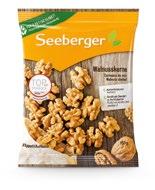
Producing countries for fruits and nuts
AUDITS AND AWARDS
Audits 2020
IFS 6.1.: higher level


Organic certification GREEN coffee range, cacao, muesli, porridge, fruits, tea, raw sugar sticks, nuts, grain, seeds
Fair trade for coffee

Producing countries for coffee and tea Sales markets
Audits 2021
IFS 6.1.: higher level
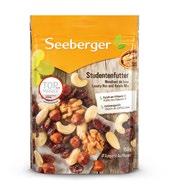
Organic certification (also: Mango and Nut-Fruit Mix)
Fair trade for coffee
11
››
››
››
››
››
››
2021
2020 Product awards Winner in the category TRAIL MIXES / NUT-FRUIT MIXES Winner in the category NUTS
NATUR WELT
12
NATURWELT | OUR SUSTAINABILITY STRATEGY
NATURWELT –OUR SUSTAINABILITY STRATEGY
Whether we’re buying new lighting systems, adjusting machine processes, travelling to work by JobBike or ne gotiating new Conditions of Purchase with suppliers: sustainability issues are a constant presence in our wor king life. A new Sustainability Report means that we are evaluating our overall performance, however. Have we achieved our sustainability goals? How much pro gress have we made? Have there been setbacks? What factors affect results?
Public awareness of sustainability issues grew during the pandemic. Good for our natural products! At the same time, we had to change complete work processes, which takes time. One of our most significant sustainability issues is packaging. Covid caused lengthy waiting periods for tests and delivery dates for sustainable pa ckaging material. The impact of this on the market only became apparent later on. We cannot let that hold us back though.
Important impetus for our sustainability strategy comes from the new German Supply Chain Due Diligence Act (LkSG): is it right to organise our issues in terms of geo graphic action fields if sustainability has no limits? We have restructured our activities as a result.
VERENA SCHÄDLER SEEBERGER SUSTAINABILITY OFFICER
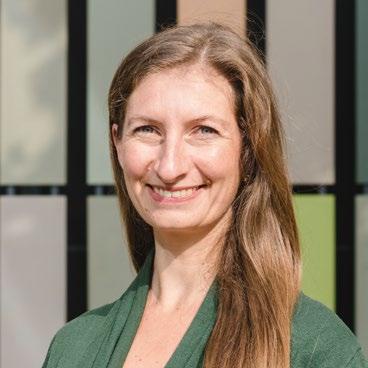
Greater transparency in the supply chain and during the pandemic as well? To achieve this we have refined our Supplier Questionnaire and the Sustainability Guidelines for suppliers and will communicate these better.
More communication: that also means internally. We have enhanced sustainability communication with fixed points of contact in Corporate Marketing. Employees are also informed about the latest news relating to our sustainability issues under the heading “NaturWelt” in the employee magazine.
More communication? We also want that with you, dear reader. Please let us know if you have any questions or suggestions about our sustainability issues or this report.
We look forward to hearing from you!
13
The Seeberger Sustainability Report: reporting standards, partnerships and memberships
›› UNITED NATIONS GLOBAL COMPACT: The United Nations global sustainability initiative. By participating in the UN Global Compact, Seeberger has been supporting the ten universal principles for human rights, labour standards, environmental protection and fighting corruption since 2015.
›› ILO CONVENTIONS: The International Labour Organisation (ILO) is a specialised agency of the United Nations. In its standards, especially the core conventions, it formulates international labour and social standards for social justice and fair globalisation and decent work as a central prerequisite in combating poverty. The ILO Standards are the basis of the Seeberger Conditions of Purchase.
›› UN SUSTAINABLE DEVELOPMENT GOALS (SDGS): Seeberger reporting has been based on the UN Sustainable Development Goals since 2016/2017.
›› GLOBAL REPORTING INITIATIVE (GRI): Basis of Seeberger reporting since 2013.
Our stakeholders
SUPPLIERS
EMPLOYEES
CUSTOMERS
CONSUMERS
SOCIETY
What issues are important to our stakeholders? We check regularly by talking to our stakeholder groups. Where do they expect solutions and involvement from us? Our Materiality Matrix makes that clear. We derive
POLITICIANS ASSOCIATIONS & INITIATIVES
our focus issues for the sustainability strategy from the matrix. We align our sustainability activities relating to the stakeholder issues with the Sustainable Develop ment Goals of the United Nations (SDGs).
14
NATURWELT | OUR SUSTAINABILITY STRATEGY
Our planning for how we want to become more sustainable takes place under the umbrella of “NaturWelt”. We used to organise our sustainability issues into the geographic action fields of “Ulm location” and “Food suppliers in source countries”. However, it is now obvious, not just because of the pandemic but also due to the tangible impact of climate change: sustainability has no limits. For this reason, we will be organising our strategy into overriding themed action fields from now on. All previous reporting standards and of course our goals continue to apply. THE PREVIOUS
15
GEOGRAPHIC ACTION FIELDS HAVE BECOME FOUR NEW THEMED ACTION FIELDS SUPPLY CHAIN RESPONSIBILITY CLIMATE PROTECTION COMMUNITY CIRCULAR ECONOMY FOOD SUPPLIERS IN SOURCE COUNTRIES ACTION FIELDS ULM LOCATION
development work
of work
family
training Compliance
culture Resources
efficiency
safety
health
crop protection
Health / education Secure & trusting partnerships
conditions
Sustainable packaging & recycling Water
Issues
Issues
Our Materiality Matrix
– our sustainability strategy
high high RELEVANCE SEEBERGER RELEVANCE SEEBERGER Foundation /
Compatibility
&
Education &
Corporate /work / management
& waste Climate (footprint) &
Occupational
&
Fertiliser &
Biodiversity
Child labour / seasonal work / working
Supply chain transparency
very high very high
at Ulm location
in source country
NaturWelt
16 Our goals by 2025 Our strategy VISION ➔ WE WANT TO CLOSE LOOPS CIRCULAR ECONOMY SUSTAINABLE PACKAGING NO FOOD WASTE // USE RECYCLABLE MATERIALS // REDUCE MATERIAL // USE ALTERNATIVE MATERIALS // NO FOOD WASTE 100 % of Seeberger packaging in the range is recyclable Reduce fossil fuels by 20 % across the whole product lifecycle Alternative packaging materials without compromising product protection Keep food waste in the production process below one percent ››› “HolyGrail” Initiative // ENSURE TRANSPARENCY // CREATE COMMITMENT // EXPAND PARTNERSHIPS Introduce transparency analysis and carry out annually Set up risk analysis in accordance with LkSG and carry out annually Introduce public complaint system Revise and update the Conditions of Purchase Increase number of direct contacts Create added value locally ››› “BioVal” Initiative SUPPLY CHAIN RESPONSIBILITY VISION ➔ WE WANT 100 % TRANSPARENCY IN THE SUPPLY CHAIN ››› Foundation of the owner family “Sternschnuppen für Kinder” The Seeberger sustainability strategy OUR FOUR ACTION FIELDS Our goals by 2025 Our strategy OUR FOUR ACTION FIELDS
CLIMATE
Create an annual climate footprint for the company
Create three product climate footprints as an example
Reduce CO2 emissions by 10 % compared to the base year 2019
Establish the “ONE SEEBERGER” project to strengthen our sense of community. Project goal: expand the “Seeberger Family” employee programme across the whole Seeberger Group
Establish a uniform management culture for the whole Seeberger Group
Expand and adapt employee participation across the whole Seeberger Group
Encourage and require achievement, in order to be successful together
Devise and adopt the “Mobile Working” company agreement
Establish a transparent and motivating salary structure
“New Work”
17
COMMUNITY // STRENGTHEN OUR BINDING CORPORATE CULTURE AND VALUES // CREATE ATTRACTIVE WORK ENVIRONMENTS
Establish the
working group to focus on networking and cooperation VISION ➔ WE WANT TO BE AN ATTRACTIVE AND SOUGHT-AFTER PARTNER // MEASURE EMISSIONS // REDUCE EMISSIONS // OFFSET UNAVOIDABLE EMISSIONS
Our
Our
Our strategy
Make the company climate-neutral from 2022 VISION ➔ WE WANT A CLIMATE-NEUTRAL SUPPLY CHAIN
PROTECTION Our goals by 2025
strategy
goals by 2025
18 VISION ➔ WE WANT TO CLOSE LOOPS CIRCULAR ECONOMY OUR FOUR ACTION FIELDS > CIRCULAR ECONOMY
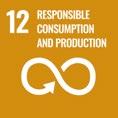
19 >>> SUSTAINABLE PACKAGING >>> NO FOOD WASTE TECHNICAL CYCLE BIOLOGICAL CYCLE Our strategy USE RECYCLABLE MATERIALS 100 % of Seeberger packaging in the range is recyclable REDUCE MATERIAL Reduce fossil fuels by 20 % across the whole product lifecycle USE ALTERNATIVE MATERIALS Alternative packaging materials without compromising product protection Our goals by 2025 NO FOOD WASTE Keep food waste in the production process below one percent We are guided by the following SDG ››› “HolyGrail” Initiative For a be t te r planet!
Promote circular economy
The principle of the circular economy is based on the example of nature. This is where what we live by as a company is created: high-quality natural products. Our responsibility to use natural resources carefully thus applies wherever our products are grown, processed, packed and shipped.
Our standard is “cradle to cradle” or: the perfect circular economy
In the perfect circular economy there is no waste. Products are manufactured in such a way that they can become new raw materials and products again with no loss of quality. The circular economy conserves resources, reduces harmful greenhouse gases and could solve the global waste problem. This process functions in two systems:
TECHNICAL CYCLE
BIOLOGICAL CYCLE
Once they can no longer be used, consumer goods are broken down into technical nutrients, which are then used to produce new consumer goods. WALNUT HARVEST
The raw materials used for consumer products bio degrade into biological nutrients after use. They are used to support plant growth of renewable raw ma terials for new products, for example.
Seeberger packaging
Our premium natural products have to reach customers safely and in the best quality. This requires excellent packaging. This also applies increasingly to its sustainability. In our pursuit of sustainable packaging we are guided by the principle of the circular economy. Our goal is for our packaging to be 100 % recycled and reused as recyclate wherever possible.
Seeberger natural products
Food like our natural products is already part of the biological cycle from its production and use to its decomposition.
20
THE
PLANT
LOCAL PROCESSING
PACKAGING
OF PACKAGING PACKAGING
THE CONSUMER
PACKAGING
>>> INTRO OUR FOUR ACTION FIELDS > CIRCULAR ECONOMY
PROCESSING AT SEEBERGER CONSUMPTION REUSE OF
SHELLS /
REMAINS
RAW MATERIALS PRODUCTION OF
MATERIAL DISPOSAL
WITH
BAG FILLED BY SEEBERGER RECYCLING OF
BIOLOGICAL NUTRIENTS
We want to achieve a circular economy precisely where we are using and influencing resources, the environ ment or climate. And where we can effect the most change: with the Seeberger packaging and the produc tion processes for our natural products from the source country to the packaging. We are working hard on this. And with success. For example: we have already con verted 94 percent of our flat bag packaging to recyc lable monocomposite film. Additionally: we currently lose less than one percent of the supplied raw product across the entire production process.
Our goals are ambitious. We keep a close eye on what developments we can use. This applies to promising so lutions wherever we use packaging. That means from the production and packaging of raw products in the source countries, to processing and repacking for retail or catering and, finally, each Seeberger pack opened by our customers for that moment of Seeberger pleasure.
21
Our strategy >>> SUSTAINABLE PACKAGING >>> NO FOOD WASTE USE RECYCLABLE MATERIALS REDUCE MATERIAL NO FOOD WASTE USE ALTERNATIVE MATERIALS HOW DO WE DO THAT? VISION ➔ WE WANT TO CLOSE LOOPS TECHNICAL CYCLE BIOLOGICAL CYCLE
Inside of the Seeberger Advent Calendar made from 100 % natural recycled fibre
2020 2019
Material reduced on 13 of our so-called doy packs – the zip-close packaging (e.g. Luxury Nut and Raisin Mix 150 g). The bag height was reduced by 2 cm, which equates to a material saving of around 5 %.
Around 90 % of products in flat bags switched to a recyclable monocomposite film , which also reduced material use by up to 20 %.
22
What have we achieved so far?
Our milestones on the road to circular economy –in our Retail division
100 % from not plastic recycled paper =5 % less material 20 % = up to Mono composite less material in flat bags >>> INTRO -2 cm height OUR FOUR ACTION FIELDS > CIRCULAR ECONOMY
Six of our zip-close bags with low grammage will be produced without the zip from spring 2022. This will enable us to save 2 tonnes of material a year.
Other products in flat and upright bags switched to recyclable monocomposite film , while also reducing material use.
23 2022 2021
No zip = material per year Mono composite = Reduced material use on flat or upright bags
-2 t
OUR FOUR ACTION FIELDS > CIRCULAR ECONOMY
A soft apricot, a crunchy cashew nut: Seeberger pa ckaging has to provide maximum protection for our unique natural products. Preserve aromas, protect against harmful germs and ensure optimal shelf life –those are our key tasks.
Can more sustainable packaging materials achieve that? Can we use less and thinner material, for example? Are there feasible alternatives made from renewable ma terials? How do we reduce material losses in the pro duction process to conserve resources better? What if
Our strategy
How does 2 REDUCE MATERIAL
the circular economy work here? 3 USE ALTERNATIVE MATERIALS
a sustainable, eco-friendly film cannot withstand tech nical processing, for example? A classic conflict of goals, because production must continue without delays and with the usual quality.
24
These are questions that have to be resolved by our Development team for more sustainable Seeberger pa ckaging. That’s why we are working across departments and on an interdisciplinary basis, looking at ideas for better, more sustainable packaging. And together they are agreeing ambitious, but realistic goals along the way. >>> SUSTAINABLE PACKAGING >>> SUSTAINABLE PACKAGING 1 USE RECYCLABLE MATERIALS

25
PACKING
TO RETAILERS
Stages in the product lifecycle of a walnut QUALITY ASSURANCE PROCESSING &
PACKING CONSUMER TRANSPORT
PRODUCT IN RETAIL
TO ULM
HARVEST, QUALITY ASSURANCE & PROCESSING IN THE SOURCE COUNTRY
TRANSPORT
1USE RECYCLABLE MATERIALS
HOW DO WE DO THAT?
Our goal by 2025
100 % of Seeberger packaging in the range is recyclable

Sales packaging
We avoid plastic combinations in sales packaging to increase recyclability. Just one polymer type should be used for all the packaging if functionally feasible. We want to use composite packaging, i.e. combinations of plas tic and other material types (paper, cardboard, metal), as little as possible. Especially if they cannot be separated easily by consumers for disposal. We are also checking what proportion of recyclate we can use to manufacture our sales packaging. This includes packaging made from reused household, industrial or commercial waste, for example.
Raw product packaging
We are working with producers and suppliers in the source countries on sus tainable solutions for raw product packaging. Our raw products come to Ulm in a variety of packaging. We also want to design this packaging to comply with the principles of the circular economy. But that is no easy task. We are working with different suppliers, whose customers in turn have individual requirements. In 2022 we also started a project: we want to increase the amount of monocomposite film in raw product packaging. Monocomposite films are highly recyclable, which makes them ideal for reuse. Because of this, we are developing a sorting system that will enable us to identify them safely and dispose of them separately when unpacking in the production process. Then we want to expand the amount of monocomposite film being used by our suppliers and convert deliveries accordingly.

26
➔ PREMISE:
OPTIMAL PRODUCT PROTECTION FOR TASTE, AROMA AND SHELF LIFE EVEN FOR LONG PERIODS
OUR FOUR ACTION FIELDS > CIRCULAR ECONOMY
Outer packaging
We are optimising our outer packaging for retail and catering. We are increa sing the amount of recycled paper in cardboard packaging and only using fresh fibre to the extent necessary to ensure box stability. We determined in a transport test: boxes become unstable if the proportion of recycled paper is too high. In 2022 we began a project to check the feasibility of using our high-quality boxes in a returnable system.
Other packaging material
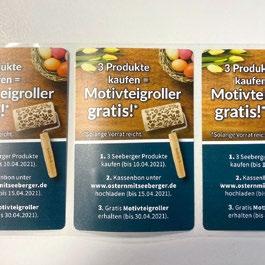
We are also looking critically at the supplementary material we use for pa ckaging: can we use more sustainable sleeves, labels, zips? The best option is to use the same substance for the packaging and supplementary material, as this increases recyclability. We are working on it.
Waste management
We want to continue optimising the sorting and disposal of packaging and working materials in the production process and at locations. In logistics we endeavour to sell transport pallets we can no longer use as a food ma nufacturer.

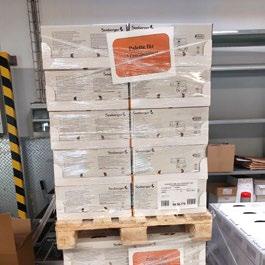
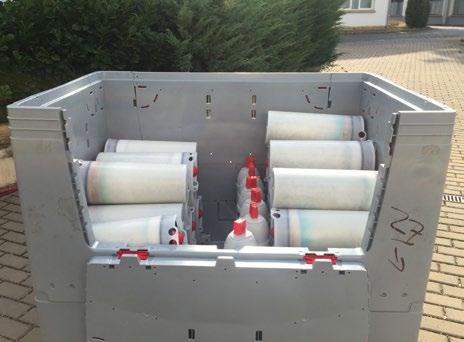
Recycling loop for water filters
We have established a new process in our Business Customer division, where filter cartridges are used for water dispensers: the cartridges for common manufacturers are now collected in boxes at our locations and taken back by the manufacturer. They thus enter the recycling loop, and waste is avoided. We are pleased that the cartridge manufactu rers offer this option, enabling us to be part of the circular economy.
27
REDUCE MATERIAL
HOW DO WE DO THAT?
Our goal by 2025
Reduce fossil fuels by 20 % across the whole product lifecycle
➔ PREMISE: MONOCOMPOSITE FILM PREFERRED. IF THAT’S NOT POSSIBLE, WE TRY TO USE THINNER FILMS.
Sales packaging

›› We check whether packaging elements can be replaced or removed, such as zips up to a certain bag size, for example.
›› We reduce packaging thickness with new, thinner generations of film. Our films are produced in Europe; most films and bags come directly from Germany or Austria. This keeps transport routes short – reducing emissions of climate-damaging greenhouse gases.
›› Good ratio: we check the ideal bag height in relation to the ideal fill level. The bag height or size for a product can be reduced depending on the amount of air or size of the product and the technical requirements for the packaging.
›› On the packaging we’ve switched to monocomposite film, we’ve saved up to 20 percent of the packaging material we previously used. 94 percent of our flat bags are currently made from monocomposite film.
›› No losses: we are working on minimising material losses in the production process. Our goal is to keep film loss on the packaging machines below one percent.
28
2
OUR FOUR ACTION FIELDS > CIRCULAR ECONOMY
Raw product packaging
›› We communicate regularly with our producers and suppliers in source countries – including about raw product packaging.

›› Our sustainability requirements in terms of packaging material are also part of the Sustainability Guidelines for suppliers in our Conditions of Purchase.
›› In 2022/2023 we want to analyse the current raw product packaging, separate/sort it accordingly and switch as much raw product packaging as possible to mono-material.
Outer packaging
›› We use optimised secondary packaging, e.g. cardboard that is produced as thinly as possible.
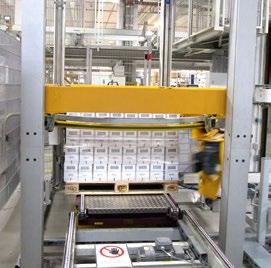
›› Thanks to a new stretch film for pallets and optimised machine settings, we have reduced our annual film use of around 20 tonnes by 45 percent.
›› We are reducing the amount of glue used to seal the boxes. Our goal: to save 20 percent of the glue while retaining the same quality.
›› Does it still make sense to have scanner strips on displays? We are dropping them in national retail stores from 2022, saving 5 tonnes of plastic a year in the process.
Sustainable packaging: classic conflict of goals
By removing the zip from small packs (60–80 grams), we can save 13 percent of the material per pack. That equates to two tonnes of plastic a year. Removing the reseal stickers would also help to save material and increase recyclability. Getting rid of small packs altogether would also be more sustainable in principle. Cons: our customers want healthy, aromatic products in practical, resealable and also small pack sizes.
UP TO 13 %
MATERIAL SAVING
per pack. We are removing the zip on six products with low grammage, as it does not provide any added value here.
29
REMOVE ZIP: KEEP ZIP: More convenient PROTECTION against loss of quality and taste
USE ALTERNATIVE MATERIALS
HOW DO WE DO THAT?
We are looking into useful applications of renewable materials such as wood and testing the use of paper in stead of plastic. For example, we use recyclable crum pled paper for packing, rather than bubble wrap, poly styrene chips or moulded polystyrene. Our cardboard packaging is made from a high percentage of recycled paper. Where possible, we also use FSC and carbonneutral paper for print material and sustainable mate rials for our advertising. We prefer regional suppliers for their production.
Paper is an excellent material for our highly techni cal packing plants. Nevertheless, we are also testing the use of paper for product packaging. Our previous feasibility testing on our packing plants looked at vari ous types of paper packaging. Unsuccessful so far un fortunately. This is because paper is intrinsically highly sensitive and requires very special handling. In addition to a paper that has a certain strength, but does not tear, we need a solution we can seal securely (= imperme able packaging), thus guaranteeing flawless product protection. This means that alternative paper versions still have to be developed and tested for us. This in turn takes time.
30
➔ PREMISE: OPTIMAL PRODUCT PROTECTION IS STILL GUARANTEED.
Our goal by 2025
Paper as an alternative renewable raw material
Alternative packaging materials without compromising product protection
3
OUR FOUR ACTION FIELDS > CIRCULAR ECONOMY
How can
use alternative materials?
Glass, paper or bio-based plastics: which sustainable packaging alternatives can we use? After all: all our natural products have different properties and thus re quirements for their packaging. This means: not every alternative to the usual packaging is suitable for the product or offers the necessary product protection. We have already tested various alternatives – and rejected them. For this reason, our packaging specialists are on the road, listening and investigating to find new solu tions that are right for us.
There already are many solutions for bio-based and biodegradable plastics made from renewable raw ma terials, e.g. made from maize or sugar cane. We haven’t yet found any bio-based packaging that can provide op timal and secure protection for our products against the effects of light and oxygen for extended periods on the shelf.
Bio-based packaging: how it works
Example of bio-based packaging The
Is no packaging the best packaging? We have tested that in food retail. And determined: there are some unresolved challenges for us. As yet there is no stan dardised filling system in food retail for unpacked food. It creates a lot of work for staff in the store, such as
Inspiring partnership: “No waste, only taste!” is the motto of our partner Samova for premium organic teas in our Seeberger Professional division. Samova uses NatureFlex™ for the teabag envelopes, which is 100 percent marine and garden-compostable. NatureFlex is a packaging film made from sustainably produced cellulose, which breaks down completely in the com post in around six weeks.

Sounds good: why don’t we do that for other packa ging? Bio-based plastics are only an option for us if they are not cultivated on farmland in competition with food. This means they must be produced from waste or a by-product of food production, for exam ple. Additionally, bio-based packaging has its own BBD and does not meet our requirements for an oxy gen barrier.
cleaning the filling station. In our experience, the requi rements of shelf life, product safety and hygiene are not yet guaranteed either. We are currently working on in dustry-wide projects to find a standardised concept for “unpacked”.
31
we
“unpacked”
concept
of our healthy natural snacks are already available in sustainable packaging. 69 % will be by approx. the end of 2022. Where do we stand in terms of sustainable packaging? In our Retail division
Available in sustainable packaging Switch to sustainable packaging underway










































































STAND-UP POUCH
Testing material alternatives with perforation resistance for two products with pointy edges
32
32 % already available in a recyclable monocomposite film 94 % will be available in a recyclable monocomposite film in 2022
52 %
Testing paper packaging, which can be disposed of with paper waste OUR FOUR ACTION FIELDS > CIRCULAR ECONOMY
94 % already available in a recyclable monocomposite film
In 2022: testing material alternatives with perforation resistance for roasted products with pointy edges







































10 of our snacks will be packed in film material containing 30 % recyclate







































In 2022: zips removed from six products with low grammage Poss. in 2023: testing of material alternatives to switch to a recyclable monocomposite film
In 2022: material reduction by switching to matt film material
Poss. 2023/24: testing of material alternatives to switch to a recyclable monocomposite film
100 % of our 2go range is available in a recyclable monocomposite film
In 2022/2023: switching to recyclable monocomposite film
33
FLAT BAG PACKAGING
ZIP PACKAGING
BARS & FRUIT BALLS
MICROWAVE POPCORN
SOFT FRUITS
Where do we stand in terms of sustainable packaging? In our Professional division
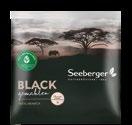
Previously
1 tonne
material saved by switching to matt film material
62 %
of the pictured product groups will be available in sustainable packaging by the end of 2022.
15 % were switched to matt film material in 2020 = 10 % less material
In 2022: 85 % will be available with non-carbon-based black and in an aluminium-free, recyclable monocomposite film
Prob. in 2023: more switched to aluminium-free, recyclable monocomposite film, as soon as remaining stock used up
In 2022/2023: testing of material alternatives to switch to a recyclable monocomposite film
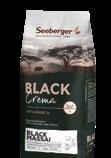

GROUND COFFEE
In 2022: 97 % will be available in an aluminium-free recyclable monocomposite film
Prob. in 2023: more switched to aluminium-free, recyclable monocomposite film
34
COFFEE BEANS 250 G
COFFEE BEANS 1 KG
OUR FOUR ACTION FIELDS > CIRCULAR ECONOMY
VENDING PRODUCTS (TOPPING POWDER, COFFEE WHITENER) 40 % are available in Green Seal paper (disposal as waste paper)





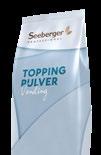





CHOCO DRINKS

In 2022/2023: testing of material alternatives to switch to a recyclable monocomposite film
In 2023: testing of material alternatives to switch to a recyclable monocomposite film
In 2022: a further 20 % switched to Green Seal paper (disposal as waste paper)
100 % of express teabags are compostable 100 % of space teabags are biodegradable
TEA CADDIES
EXPRESS AND SPACE TEABAGS 100 % durable, recyclable tinplate, refillable

TEA REFILL BAGS
In 2022: testing of recyclable material alternatives
In 2022/2023: testing of material alternatives to switch to a recyclable monocomposite film or to Green Seal paper
35
FOOD PRODUCTS (SUGAR, COFFEE CREAM & WHITENER, PASTRIES, INSTANT COFFEE)
“HOLYGRAIL” INITIATIVE
Interview
Is innovative digital technology the solution for the circular economy of packaging? 160 companies and institutions across Europe have come together to tackle this question in the “HolyGrail” Initiative – we are part of it. Our goal: to make the circular economy for packaging possible together. Our expert Christina Köhn explains how in the inter view.

160 companies are working together on a solution for per fect recycling. Why is Seeberger supporting the “HolyGrail” Initiative?
The question is: how can we design packaging so that it can be completely reused? We are not tackling this question alone: it affects companies along the entire packaging added-value chain worldwide. Indeed, the challenges of large-scale packaging waste require solu tions on a grand scale. The aim of the initiative is to es tablish an efficient circular economy for packaging. We are playing an active role by supporting the develop ment process financially and contributing knowledge, requests and questions. Efficient, high-quality recycling is an important goal both in terms of environmental policy and from a commercial perspective. In the ideal cycle we would simply reuse our recycled packaging as a secondary raw material for new packaging. These raw materials are too valuable simply to thrown away.
What might this solution look like?
The prerequisite for optimal recycling is that packaging can be sorted efficiently at the sorting plant. This is pre cisely where “HolyGrail” focuses. A digital watermark on packaging will facilitate exact sorting of different types of plastic. Lots of other information could also be sto red. Waste sorting plants could identify Seeberger pa ckaging from the watermark, for example, and read that this was used for walnuts and is made from monocom posite material. The sorting plants can then place it cor rectly in the right material section. Unmixed waste can be used to produce very high-quality recyclate, which is then fed back into the cycle. This is not possible yet with current technology.
Can Seeberger packaging be tagged with the digital water mark?
That is already technically feasible. It was already suc cessfully tested in the “HolyGrail 1.0” phase. Current tests with watermarks on packaging in circulation will be completed and evaluated by the end of 2022. We are very excited about the results.
36
OUR FOUR ACTION FIELDS > CIRCULAR ECONOMY
CHRISTINA KÖHN SEEBERGER PRODUCT MANAGEMENT
The high-resolution camera detects the digital watermark and decodes its information.
Packaging waste coded with digital watermarks arrives at the sorting plant.
Copyright: AIM/HolyGrail2.0. “Digital Watermarks Initiative HolyGrail2.0*”

*Driven by AIM – European Brands Association, powered by the Alliance to End Plastic Waste.
Packaging waste is sorted for recycling in various streams (e.g. food vs non-food).
37
1
2 3
Customers don’t just find well-protected, delicious products in our packaging. Hard work, resources, ener gy and genuine passion are also in there. Naturally we don’t want to lose this valuable food during the produc tion process.
No losses: that is a matter of course for us! Our strategy
“No Food Waste!”: that’s not just an economic neces sity, but also a question of respect and appreciation. The packaging is an important part of the solution: it protects our product perfectly down to the last nut or apricot. And what else can we do?
NO FOOD WASTE
HOW DO WE DO THAT?
38
>>> NO FOOD WASTE >>> NO FOOD WASTE Keep food waste in the production process below one percent Our goal by 2025
OUR FOUR ACTION FIELDS > CIRCULAR ECONOMY
Produce food – without losses Process food carefully
Keep food and resource losses as low as possible: that is part of our Conditions of Purchase for producers and suppliers in source countries. However, they themsel ves are very interested in avoiding food losses. Rejects or waste are used with resource conservation in mind. Nut shells are used to heat greenhouses, for example, while grape stalks are used for animal feed and rejected sultanas are used to make vinegar. We also use our sustainability questionnaires for suppliers to find out whether there is composting or a biogas plant for natu ral waste, for example.
Where do food losses occur in the current production system and what is causing this? Our current set-up is very good: our current losses in the production process are less than one percent of the total tonnage of sup plied raw product. To ensure this remains the case, we are vigilant about potential causes:
›› we are analysing the causes of raw product breakage and reducing this with appropriate countermeasures. We are optimising our machine settings, for example.
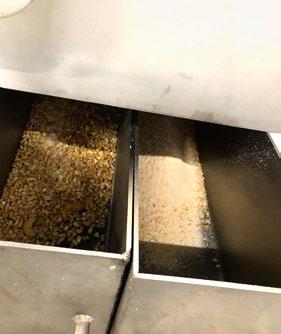
›› if broken goods are still top quality, but not suitable for sale, they are packed as separate items for the Seeberger Genusswelt.

›› only broken goods that are not suitable for consumption are disposed of as biowaste.
Optimising food waste from
Recycling of almond trees
Almond trees usually live for 25 years. At the end of their productive life, whole almond trees are shredded and worked back into the soil. This ensures fixed carbon is stored in the ground in the longer term. This also helps to counter climate change. 2.4 tonnes of carbon can be fixed per hectare in this way, which corresponds to living without a car for a year. This also im proves soil health incidentally, which is reflected in better water storage capacity and higher yields.
Cashew Nuts roasted
& salted
With our old screening technique, salt and broken cashews were screened out together. Because the screened product contained a lot of salt dust, it had to be dis posed of. Thanks to changes in our screening technique, we are now able to screen out broken cashews and salt separately, which means we can sell the broken cashews in our Genussmarkt.
Mango waste recycling

The fruit and the ground waste (mango stones, fruit skin and coconut husks) are composted into organic fertiliser. The fertiliser is worked into the ground to improve fruit and soil quality.
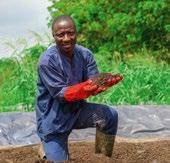
39
40 VISION ➔ WE WANT 100 % TRANSPARENCY IN THE SUPPLY CHAIN SUPPLY CHAIN RESPONSIBILITY OUR FOUR ACTION FIELDS > SUPPLY CHAIN RESPONSIBILITY
For a be t te r planet!
Our strategy
ENSURE TRANSPARENCY

Our
goals
by 2025
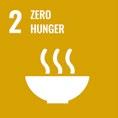
Introduce transparency analysis and carry out annually Set up risk analysis in accordance with LkSG and carry out annually Introduce public complaint system
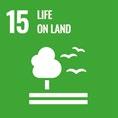

CREATE COMMITMENT Revise and update the Conditions of Purchase
EXPAND
PARTNERSHIPS
Increase number of direct contacts Create added value locally
41 We
the following SDGs ››› “BioVal”
›››
are guided by
Initiative
Foundation of the owner family “Sternschnuppen für Kinder”
Corporate due diligence: for more than 175 Years
In 2016 the German Federal Government published its National Action Plan (NAP), in which it defined its ex pectation that all companies should: introduce the pro cess of corporate due diligence in a manner commen surate with their size, the sector in which they operate, and their position in supply and value chains”.
At Seeberger, corporate due diligence respecting human rights and the environment has a tradition stretching
back more than 175 years. Fair supply partnerships and respect for people and nature in the countries where we source our products are a matter of course for us. They are part of our corporate values and they are the basis of our history and our success. In 2020 the Federal Government reviewed implementation of the NAP with German-wide monitoring. We took part in that. The re sult? We fulfil nearly all of the five central pillars of the NAP process.
Milestone – German Supply Chain Due Diligence Act (LkSG)
From 2023 the LkSG will apply to all companies with more than 3,000 employees located in Germany. We support the LkSG. And it challenges us, because it sub stantially exceeds the requirements of the National Ac tion Plan. The LkSG also requires companies to act with appropriate due diligence in respect of human rights and the environment. Admittedly, the LkSG does not apply to us as a company because of our size: nevertheless, it is our ambition to implement the due diligence required by the LkSG in full.
This Act will help to improve protection for human rights along global supply chains. It is about preventing child and forced labour, supporting fair trade and paying fair wages, for example. Agricultural supply chains should be encouraged to ban substances that are harmful to people and the environment. Compliance with this due diligence is covered by the Conditions of Purchase ag reed with our suppliers.
Opportunities of risk analysis: example of child labour
Child labour is strictly forbidden in Seeberger suppliers by the Conditions of Purchase. We are currently tes ting the following procedure in the monitoring cycle: internal monitoring is triggered if the risk analysis for a country or region has identified this issue. Does a See berger supplier work there? The Seeberger transparency analysis shows the level of our supplier contacts. In the next step, we compare this with the Supplier Question naires for the relevant suppliers. A supplier can use the questionnaire to prove that there is no child labour in its
operation despite the high risk shown for the region in the risk analysis. On the next site visit, our Seeberger buyers check whether the information fits with their personal impression. They sit down with the Seeberger Sustainability team to prepare before visiting the source country and are given a detailed checklist. They look for solutions together if their conclusion is negative.
42
>>> INTRO OUR FOUR ACTION FIELDS > SUPPLY CHAIN RESPONSIBILITY
Seeberger supplier monitoring
The Seeberger Sustainability Guidelines have been an integral part of our Conditions of Purchase since 2012. We use Seeberger supplier monitoring to check whet her and how they are being complied with. The point of this is not just to check compliance with our Conditions of Purchase and Sustainability Guidelines. It helps us to develop and improve processes and management and to demonstrate that we are performing our due diligence.
Our supplier monitoring comprises complementary test modules. The modules are designed so that each one in the process helps to improve the others on an ongoing basis. This is essential for our working life: we identi fy risks quicker and can react appropriately. We gather important information that we can uses to different iate our Supplier Questionnaires. This improves how they are understood and answered. The Sustainability Guidelines are also part of the cycle. By continuing to adapt and differentiate our supplier monitoring, we en sure the high quality of our natural products and promo te sustainability during production.
Modules of Seeberger supplier monitoring
SEEBERGER CONDITIONS OF PURCHASE & SUSTAINABILITY GUIDELINES:
integral contract component for all Seeberger suppliers
DATA-BASED RISK ANALYSIS (BEING DEVELOPED):
evaluation of generic data sources for social or ecological risks in Seeberger supplier countries and regions.
SEEBERGER TRANSPARENCY ANALYSIS:
in the transparency analysis* a classification system is used to evaluate where we procure our products and how far we can trace them. The results are fed into the risk analysis.
SUPPLIER QUESTIONNAIRES:
digitalised questionnaires* for self-disclosure by suppliers. In the longer term, they are used to develop an individual sustainability index for suppliers. These results are also fed into the risk analysis.
PERSONAL CONTACT: *
purchasing trips and current trips in the context of the BioVal research project, personal contact at trade fairs, during visits to Ulm or at conferences . The information in the Supplier Questionnaires is checked on a random basis using checklists during visits to source countries
Fed into the risk analysis
43
What have we achieved so far?
Supplier Questionnaire created and first survey of suppliers
ENSURE TRANSPARENCY
CREATE COMMITMENT
Sustainability Guidelines created and communicated to suppliers
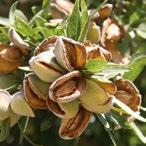
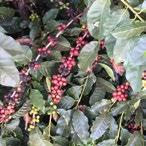
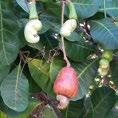
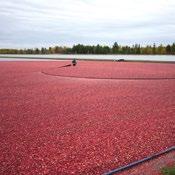


Sustainability Guidelines refined / part of our Conditions of Purchase since then
EXPAND PARTNERSHIPS
Source country visits to...
44
2015 2016 2014 2013 2012
>>> INTRO OUR FOUR ACTION FIELDS > SUPPLY CHAIN RESPONSIBILITY
California Canada Brazil Bolivia Ghana Vietnam
Analysis of results
Supplier Questionnaire refined based on strengths and weaknesses of results
Analysis of results = understanding of social and ecological impact
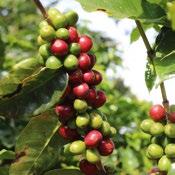


Second survey Optimising the Supplier Questionnaire
Slovenia
Nicaragua
Ghana
Transparency analysis set up to identify where and how direct our buying is
45
2020 2021 2019 2018 2017
46 Our strategy VISION ➔ WE WANT 100 % TRANSPARENCY IN THE SUPPLY CHAIN Introduce transparency analysis and carry out annually Set up risk analysis in accordance with LkSG and carry out annually Introduce public complaint system 1 ENSURE TRANSPARENCY 2 CREATE COMMITMENT 3 EXPAND PARTNERSHIPS HOW DO WE DO THAT? 1 ENSURE TRANSPARENCY Our goals by 2025 OUR FOUR ACTION FIELDS > SUPPLY CHAIN RESPONSIBILITY
Transparency is the prerequisite for change. Yet our sup ply chains are complex. We do not source all products direct from the producing operations. The importance and value of sustainability issues also vary widely for our suppliers. This is demonstrated by their answers in our Supplier Questionnaires. In our questionnaire analysis in 2021 we identified that understanding of the questi ons varies, which means that there are gaps in the ans wers at times. As a result, we don’t always achieve the desired transparency and cannot have the same influen ce over sustainability issues everywhere.
TRANSPARENCY ANALYSIS NUTS/FRUITS
13,24 %
11,46 % 75,24 %
2021
Our Supplier Questionnaires should provide a picture of the local reality. How is that possible though if the supplier is not a farm in the source country, but an im porter in Germany? How specific are the answers and how much do they help us to achieve greater transpa rency? We want to find out how “close to the field” we are getting with our suppliers. We have been creating a transparency analysis for this purpose since 2020. It shows us how close to production our suppliers work in product categories arranged by delivery stages. The “closer” they are, the more possibilities we have of wor king together on sustainability issues.
TRANSPARENCY ANALYSIS RAW COFFEE
Supply stages
Producer/producer group
Commodity traders in the source country Processor/packer/ cooperative in the source country Trader/exporter in the source country Trader/importer/packer in D/EU
We have very high transparency and can trace the majority of our products back to the producer. At the same time, we also identify areas that require attention and take steps to rectify this.
33 % 2020
12 % 2 % 13 % 13 % 27 %
Producer Producer group Wet mill Dry mill Cooperative Region Exporter Source country
We have very high transparency for 73 % of our coffee. For the remaining 27 % and especially the 12 % for which we only know the source country, we are actively working to improve transparency.
Greater transparency using Supplier Questionnaires?
Our experience shows: yes! And: no! This is because our Supplier Questionnaires are answered subjecti vely. There is a difference whether an almond comes from the USA or a walnut comes from Chile.
Learning and improving together
To derive specific measures from the Supplier Question naires, they have to be customised and meaningful. Our current partner and research project “BioVal” is helping with our advanced questionnaire quality update. We will make our Supplier Questionnaires more distinct and
Our conclusion after many years of evaluating Supplier Questionnaires: they are unavoidable, because they definitely show us whether and where we need to take action. And they make it clear to our suppliers how im portant local sustainability issues are to us.
efficient for all issues using a methodology developed jointly for the research topic “Valuing biodiversity in the product lifecycle”. Our goal: to learn from one another in this process with expert partners and suppliers and thus improve.
47 Die Seeberger-Transparenzanalyse
Seeberger and the Orang Utan Coffee Project
Seeberger is one of the oldest coffee roasting businesses in Germany. Outs tanding aromatic coffees are at the heart of our range for catering and busi ness customers. With the “Orang Utan Coffee Project” we are taking re sponsibility for transparent, fair and sustainable coffee production from the plantation to the roasting plant. Orang Utan Coffee is produced by small holders on the Indonesian island of Sumatra. Around 350 families run their small coffee farms in accordance with strict “Orang Utan Coffee” guidelines. These set out requirements for organic cultivation and nature conservation. This also includes a ban on logging in the primary forest. It is also forbid den to hunt, trap, keep or trade protected animal species. The families are committed to protecting the rainforest, its animals and plants. They receive a bonus for this of €0.50 per kg raw coffee. An additional €0.50 goes to the Sumatran Orangutan Conservation Programme (SOCP). The SOCP works to preserve Sumatra’s dwindling lowland rainforest. It operates four research stations and runs extensive environmental education programmes.

48
Revise and update the Conditions of Purchase HOW DO WE DO THAT? 2 CREATE COMMITMENT Our goal by 2025 OUR FOUR ACTION FIELDS > SUPPLY CHAIN RESPONSIBILITY
Commitment: for us an obligation to cooperate in an open, friendly and respectful manner with everyone we encounter at Seeberger. Above all, however, it means: reliability. We trust our supply partners; they trust us. Transparency is also the basis of these often long-term partnerships.
What we expect is clearly expressed in our Conditions of Purchase. This also applies to sustainability issues. Our Sustainability Guidelines are an integral part of the Conditions of Purchase and thus a contract component.
49
exactly does
What
“commitment” mean to us?
The Seeberger Sustainability Guidelines & Supplier Questionnaire
›› Guaranteeing occupational safety and health protection ›› Maintaining social standards ›› Fair pay ›› Basic social security for illness, holidays, maternity leave and retirement ›› No forced labour ›› No exploitative child labour: the employment of minors must not involve any physically difficult or dangerous work or restrict school attendance ›› No physical, verbal or financial discrimination based on ethnicity and national origin, religion or gender ›› No bribery or corruption ›› There is freedom of assembly and association ›› Responsible handling of natural resources like water, soil, energy ›› Careful management of plantations for the best product quality, with as little environmental impact as possible ›› Use of pesticides and fertilisers only as strictly necessary ›› No genetic engineering ›› Avoid monocultures ›› Preserve and promote biodiversity SOCIAL ISSUES: HUMAN RIGHTS OBLIGATIONS SUSTAINABLE AGRICULTURE: ENVIRONMENTAL OBLIGATIONS
Two years of pandemic: aspiration and reality
2020: our supply chains are strained. Covid is also cau sing problems for us. Staff shortages, travel restrictions – Purchasing is under a lot of pressure. Development of our sustainability issues is not possible in the way we had planned. Consequently: there is a lot of discussion. Not least because the LkSG is now an aspiration for us.
We are also noticing that consumers expect more from us. More perhaps than is possible at the moment when we can only achieve varying levels of transparency on the ground. What we are pleased about? The pandemic has clearly increased public awareness of sustainability issues.
Top issue for corporate planning: sustainability in Purchasing
In 2021 the LkSG is one of the top issues in Purchasing at Seeberger. Thus, sustainability is firmly established in the corporate goals. Purchasing trips to source count ries? Only after internal consultation including checklist on sustainability issues. We are increasing sustainability
awareness in Purchasing with more training. And there’s a boost for our Purchasing team: from 2022 an assistant and a temporary intern for Purchasing Management and Supply Chain.
Our goals by 2025
50
Increase number of direct contacts Create added value locally HOW DO WE DO THAT? 3 EXPAND PARTNERSHIPS OUR FOUR ACTION FIELDS > SUPPLY CHAIN RESPONSIBILITY
Purchasing trips: communication on the ground

Relationships with our suppliers – for us this has always been a case of communicating as equals. Nothing helps us to understand our supplier partners more than a pur chasing trip to the source country. And vice versa. They are the foundation of trusting cooperation. They enable

us to swap our experiences and learn from one another. We understand the local issues better, can convey the knowledge we bring more specifically and personally. After almost three years with just a few trips to source countries, in 2022 we are keen to get back on the road.
Not being there but still maintaining partnerships
Communication – we’ve always had that: every purcha se and every Seeberger product delivery involves inten sive email, virtual or telephone contact. This also hap pens if we are developing new products with suppliers
or producers and when there is feedback or complaints. Trade fairs are an important place for meetings: in 2021 we used the Anuga intensively again for personal mee tings and to maintain partnership connections.

First mangos, then coconut chips – an important partner for 10 years
Our new Coconut Chips have been on sale since July 2021. More than any other product they re present a close and successful partnership with producers in the source country. This not only goes for the high quality of the fruitily crisp chips, but also for sustainability and transparency. The coco nuts grow in near-natural palm forests. Production residues are made into organic fertiliser, which ensures the ground is fertile for the next generation of coconuts. We have been working with our partner operation in Ghana since 2012. It is one of the biggest employers in this region of Ghana, offering a year-round, secure income to more than 1,000 workers. More than 1,000 small farms in the region also supply the fresh coconuts. Workers have access to free food in the canteen, trans port to work and a company preschool on site for their children. There is also an opportunity for professional development.
51
“BIOVAL” RESEARCH PROJECT INITIATIVE –BIODIVERSITY VALUING & VALUATION
Interview
Seeberger is a practical partner in the “BioVal” research project. How can com panies contribute to greater biodiversity in the product lifecycle? The question is at the heart of the research team’s work. With con crete examples for practical application and implementation, the project develops re commendations for company management and communication, for how biodiversity can be protected, promoted and communi cated. Verena Schädler, Sustainability Offi cer at Seeberger, is supervising the project.
What is the “BioVal” research project?
Scientists are working with practical partners in the BioVal research project, i.e. companies from the food industry, to investigate how we can reduce the nega tive impact of production and food consumption on biodiversity. We also want to find out how consumers can be made aware of the significance of biodiversity, so that they pay more attention to that when choosing their products.
Why is that important?
The diversity of ecosystems is one of the most import ant foundations of life on Earth. Genetic diversity of animals and plants ensures our survival. And they are disappearing now faster than ever before. We see the preservation of biodiversity as the essential task of the future.
SCHÄDLER SEEBERGER SUSTAINABILITY OFFICER

What role does Seeberger play in the project?
The BioVal practical partners are investigating specific biodiversity issues in the product lifecycle in “real labs”. Our issue: cultivation, as the first part of the supply chain. We want to learn how our impact on biodiversity in source countries can be measured and evaluated. So the aim of the Seeberger “real lab” is to show how pre serving and encouraging biodiversity can be integrated into supplier management. BioVal will play a significant role for us in future in supplier monitoring – not just for the biodiversity aspect. The joint research findings and results are fed into our supplier management.
52
OUR FOUR ACTION FIELDS > SUPPLY CHAIN RESPONSIBILITY
VERENA

53 Valuation of biodiversity Social values Communicating biodiversity Biodiversity impact assessment Biodiversity recording & practicability Biodiversity in companies Formative evaluation & iterative readjustment OIB D I V E R SIT Y W O RKI N G G R PUO Instruments & recommendations
The private foundation “Sternschnuppen für Kinder” (“shooting stars for children”) of Seeberger owner Clemens Keller and his wife Alexandra provides lasting help to children and young people in need all over the world. The funding projects focus in part on agriculture
and nutrition. In additional to financial aid, the aim is to help people help themselves, ensuring they are equipped to improve their own living conditions in the long term. All projects are carefully selected and are im plemented with established local project partners.
The Sternschnuppen projects
Guatemala: “Protect Nature – Support Farming Families”
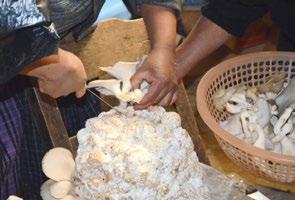


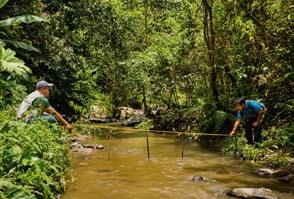
Sustainable land use (2021–2023)
70 percent of farming families in the indigenous rural population in the Sololá highlands are poor. They are overexploiting their natural resources of water, forest and soil to support themsel ves. There is no regulated land use. Many farmers are burning sections of forest because harvest yields are declining. The clea red sections only provide good yields for a few years, however. Valuable farming land is being lost to streams due to soil erosion, while water quality is deteriorating. Farmers are also fighting in creasing drought caused by climate change. This project helps to raise awareness of environmental and resource protection through workshops and to establish additional sources of agricul tural income. A new weather station, a climate network and reforestation of lost forest will help to improve evaluation of the local climate situation and help the people react to the conse quences of climate change.
54
The foundation of the owner family “Sternschnuppen für Kinder”
OUR FOUR ACTION FIELDS > SUPPLY CHAIN RESPONSIBILITY
Burkina Faso, West Africa: “One Class for All” Inclusive education in poor areas (2020–2023)

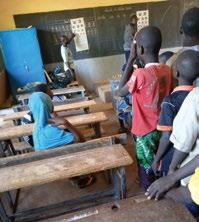
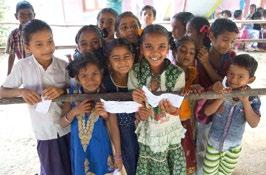
In Burkina Faso a child with a disability is more than twice as likely to miss out on school than a child with no disability. The foundation is supporting the international non-profit organisation “Light for the World”. It has been working for the rights and social inclusion of people with disabilities in poor regions of the Earth for more than 30 years. This project helps children with a disability in Kossi Province in north-western Burkina Faso to exercise their right to education and an autonomous life. To achieve this, “Light For The World” is building a sustainable supportive learning environment in collaboration with local partners.
Nandapur, West India: Uppahar Student Care Centre Child education and health (since 2017)
More than 20,000 people of various tribes, castes and religions live in Nandapur block in the district of Koraput in Odisha. Our project partner “Uppahar” started the Uppahar Student Care Centre (USCC) here back in 2018. The centre provides regular healthcare, education support and a daily hot meal to children from poor families whose parents are not able to provide for them properly. Uppahar motivates the children to take an interest in their education and encourages the parents to give their children a good education.
Current projects
GUATEMALA
“More than Maize for Mayan Children” (2020–2022)
Nutritional education, food security, improving cultivation methods, sustainable management and land use, hygiene trai ning, building trust for the use of local health centres. Goal: prevent malnutrition and increase nutritional competence.
INDIA
“Uppahar”: child education projects (since 2017)
Supporting the “Uppahar” child welfare organisation. Help with basic medical supplies with one-day “Uppahar health camps” for destitute families in surrounding villages. Help for various child education projects: providing children from poor families (caste system) with school materials, uniforms, bus ti ckets, enabling them to go to school. Supporting the Uppahar centres so that school-leaving qualifications and food security can be achieved.
Completed projects
GUATEMALA
“A Successful Start to Life” (2019–2021)
Preschool support, parent education and community organi sation in 16 Mayan communities in the Atilán highlands. Goal: successful school careers, educational support and poverty prevention.
Smallholders in Guatemala Income and food security for smallholdings in the Guatemalan highlands. Establishing expertise and community structures: field schools to establish mixed cultivation, preventing depen dence on just one crop. Knowledge of sustainable and ecofriendly cultivation. Expansion of crops, e.g. bananas, honey (beekeeping), coffee.
›› View all projects: www.sternschnuppenfuerkinder.de
›› Our project partners: Guatemala: Vivamos Mejor, Asunción Vivamos Mejor, Panajachel India: “UPPAHAR” welfare organisation Burkina Faso, West Africa: “Light For The World”
55
56 VISION ➔ WE WANT A CLIMATE-NEUTRAL SUPPLY CHAIN
PROTECTION OUR FOUR ACTION FIELDS > CLIMATE PROTECTION
CLIMATE
For a be t te r planet!
Our strategy MEASURE EMISSIONS
REDUCE
EMISSIONS
OFFSET UNAVOIDABLE EMISSIONS
Our goals by 2025
Create an annual climate footprint for the company
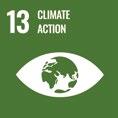
Create three product climate footprints as an example
Reduce CO2 emissions by 10 % compared to the base year 2019
Make the company climate-neutral


We are guided by the following SDGs

57
Climate protection at Seeberger
Record temperatures, drought, flooding – the impact of climate change is clearer than ever. And not just in remote producing countries. In Europe too, climate change is apparent with storms, melting glaciers, record heat, widespread fires and many other changes. What does that mean for us?
Our natural products are grown in many countries affected by climate change. Whether hazelnuts from Italy or walnuts from Chile: climate change has an im
pact on the cultivation and harvesting of our products around the world. Growth cycles are shifting, while har vests are smaller or non-existent due to flooding or late frosts. Climate protection is not just a political or social task then. For us it is – and will increasingly be – part of everyday workflows and far-reaching strategic decisi ons. That’s because we not only promise our customers outstanding quality of natural products. We also want to ensure that they can be grown in the source country for generations to come.
No strategy without footprint: the Seeberger climate footprint
We’ve been creating our climate footprint since 2013. It is the starting point and, every two years since then, also the result of our climate protection strategy. The Seeberger climate footprint measures where CO2 emis sions occur at our location and in production and how much. How can we reduce these emissions? And what can we do if there are areas where this is not possible?
These are tasks of our climate protection strategy. Our climate footprint also shows the effectiveness of our climate protection measures. It shows that Seeberger colleagues in all areas of the company can do something for climate protection with good ideas, efficient measu res, in big and small steps.
The next step: our road to climate neutrality
Our vision is a climate-neutral supply chain. We’re ex panding the climate protection action field to achieve this. We’re saving energy wherever possible. We’ve been using 100 percent green energy since 2014 and more and more e-mobility. We produce energy oursel ves using modern photovoltaic systems – and much more.
Our next milestone: a climate-neutral company using offsetting projects. In future we will offset the CO2 emissions we are unable to eliminate ourselves through carefully selected, certified climate protection projects.
And what about the climate-neutral supply chain? First another footprint. From 2023 we will be creating an example product climate footprint for each of our pro duct categories fruits, nuts and coffee. The results of this will help us achieve climate-neutral supply chains.
58
>>> INTRO OUR FOUR ACTION FIELDS > CLIMATE PROTECTION
Swapping cardboard, film and rubbish compactors

Thanks to an optimised pro cess, the containers are only collected if the fill level is re ported as “full” by the system. This reduces our energy requi rement and avoids unnecessa ry collection trips, thus redu cing CO2 emissions.
Window renovation in production

The windows in our produc tion area have been replaced in two stages with triple-glazed aluminium windows. The new windows are energy-optimised and insulated.
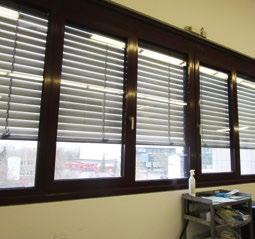
Lighting changed to LEDs

The lights at our location are gradually being replaced with LED lighting. This will reduce CO2 emissions by around 250 tonnes a year.
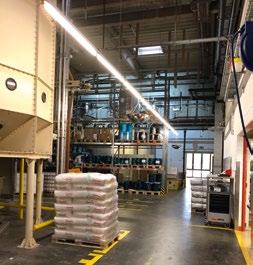
59
Coffee roasting plant “before” with old lighting
Coffee roasting plant “after” with LEDs
What have we achieved so far?
MEASURE EMISSIONS
First climate footprint (every two years since then). Our first goal: 10 percent less CO2 by 2018 New modern highbay warehouse with innovative storage technology
Conversion to 100 percent green energy Start of retrofitting with LED lighting
Second climate footprint
First photovoltaic system on the roof of Administration (85 kWp)
60
REDUCE EMISSIONS OFFSET UNAVOIDABLE EMISSIONS
2016 2013
2014
2015
>>> INTRO OUR FOUR ACTION FIELDS > CLIMATE PROTECTION
Third climate footprint
Goal exceeded: greenhouse gases reduced by 21 percent compared to the base year 2013. Our goal was -10 %.
Fourth climate footprint New base year for our climate protection strategy: system limits expanded to include subsidiaries (acquisitions).
A new reduction target defined for 2025: reduce greenhouse gases by another 10 percent compared to the base year 2019.
Second photo voltaic system on the roof of the GenussWelt (63 kWp)
Fifth climate footprint
Third photo voltaic system on the roof of the high-bay warehouse and the bridge (650 kWp). Approx. 14 per cent of our total energy need
Climate-neutral company
61 2018 2017 2022
2020
2019
62 Create an annual climate footprint for the company Create three product climate footprints as an example 1 MEASURE EMISSIONS 2 REDUCE EMISSIONS 3 OFFSET UNAVOIDABLE EMISSIONS Our strategy VISION ➔ WE WANT A CLIMATE-NEUTRAL SUPPLY CHAIN HOW DO WE DO THAT? 1 MEASURE EMISSIONS Our goals by 2025 OUR FOUR ACTION FIELDS > CLIMATE PROTECTION
The Seeberger climate footprint
Seeberger has grown thanks to the strong demand for nuts and fruits during the Covid pandemic – the logis tics for the flows of commodities was also very chal lenging. Because of this growth and the challenges in logistics, our absolute emissions have also increased. In relative terms, our emissions per employee (FTE) or per € turnover have remained steady or dropped slightly,
however. We have only got a little closer to our goal of reducing by another 10 % by 2025 – but we are moving in the right direction. We want more exact information from 2022 onwards: we will be creating our company climate footprint annually and also want to calculate three product climate footprints as examples.
63
››
››
››
››
SCOPE 3: ›› business travel ›› import logistics ›› distribution to the delivery address ›› water / waste water 17 % 2,250 t CO2 23 % 3,446 t CO2 60 % 9,054 t CO2 15,021,078 t CO2 2013 old base
2017 2019 new
2021 100 t absolute g per
turnover 10
per
140 120 100 80 60 40 20 0 *CO2 = includes other greenhouse gases besides carbon dioxide
SCOPE 1:
energy consumption & own energy production
vehicle fleet
cooling agent losses & inert gases SCOPE 2:
purchased power and district heating
year
base year
€
kg
tonnage t per FTE
HOW DO WE DO THAT?
Our goal by 2025
Reduce CO2 emissions by 10 % compared to the base year 2019
Reducing emissions means: saving energy or producing our own
How are we managing to reduce climate-damaging CO2 emissions in order to protect the climate? We are saving energy. And we are producing our own – renewably of course. And have been doing so since 2016 by installing and expanding photovoltaic systems. We are moder nising our operating areas and buying energy-efficient production machinery with the associated energy ma nagement.
Our cutting-edge high-bay warehouse: naturally cooled with groundwater. Our energy supply: 100 percent green energy since 2014. We have grouped many other measures together to reduce CO2 emissions in areas in which they arise to a significant extent. And where peo ple work who can play a part in continuing to reduce them. At Seeberger there are initiatives, training and a great deal of involvement.
Save energy: examples for greater climate protection
MOBILITY
›› Increase the number of electric vehicles in the fleet (currently 8 percent) and charging stations
›› Climate-friendly mobility concept for employees: offer free annual travel card for public transport and “JobBike”
›› Offer “Twogo” app for carpools with nearby companies
64
2 REDUCE EMISSIONS
OUR FOUR ACTION FIELDS > CLIMATE PROTECTION
INFRASTRUCTURE
›› 100 percent green energy since 2014
›› Increase photovoltaics to 60 percent
›› Install more LED lighting
›› Buy new, energy-efficient machinery and plants
›› Energy-efficient building technology: refurbishment measures for the building envelope, e.g. insulated window glazing in production area
›› Energy-efficient cooling systems in the high-bay warehouse
›› Swapping cardboard, film and rubbish compactors for modern versions, which alert the disposal companies automatically that collection is required once the fill level is reached (previously a fixed schedule regardless of fill level)
›› Corridors and WCs with motion sensors for lighting
TRANSPORT LOGISTICS
›› Eco-friendly transport logistics for our raw products with ship transport (93 percent ship, 7 percent train/lorry)
›› Avoid transport by air freight ›› Containers as fully loaded as possible
SERVICES
›› Energy-efficient coffee and snack vending machines for our corporate customers
›› Reducing monitoring visits by our field team: maintenance of snack machines for our corporate customers using electronic data transfer via telemetry
TRAINING & ENGAGEMENT
›› Less transport weight: fruits are dried in the source country, often using the sun or renewable energy. This means less weight has to be transported compared to fresh products. So we save transport energy and CO2 ›› Climate-neutral parcel shipping to customers with “Go Green” ›› IHK training programme for our trainees: EnergieScouts ›› Employee initiatives for sustainability: Seeberger Nature Ambassadors: and Seeberger Ideas Workshop
65
Natural products from all over the world – unavoidable?
We source our natural products from more than 40 countries worldwide. They are cultivated wherever the growing conditions are optimal.
We all understand that exotic natural products can’t be grown just round the corner. But what about hazelnuts or apples, which are also grown in Germany? Couldn’t Seeberger get them from Germany – much closer to the site in Ulm and without having to travel long distances?
Unfortunately, it doesn’t quite work like that. On the one hand, this is because the quantities available are sadly far too small. On the other hand, not many varie ties of a product are offered, so the quality we require just isn’t available.
We know that the import logistics for our fruits, nuts and coffees – because they are often grown very far away – result in climate-damaging emissions.
Because of this, most of them are processed locally be fore they are shipped: fruits, e.g. mountain figs are dried in the growing region in Turkey – this means they weigh less for transport. Instead of energy-intensive drying in ovens, they can be dried there in the sun – that saves CO2

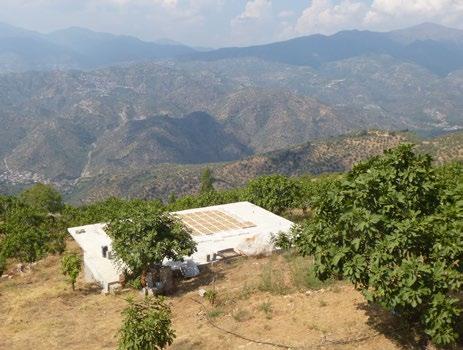
And even if it takes a bit longer, our natural products never travel by plane, but by ship and then by train and lorry.
Because we don’t get our raw products delivered just in time, we pay more attention to fully loaded containers to minimise the number of journeys required.
66
FIGS DRYING IN THE SUN
DRYING IN THE SUN OUR FOUR ACTION FIELDS > CLIMATE PROTECTION
MOUNTAIN
APRICOTS
OFFSET UNAVOIDABLE EMISSIONS
HOW DO WE DO THAT?
Our goal by 2025
Make the company climate-neutral from 2022
What does “climate-neutral company” mean?
We are reducing our climate-damaging CO2 emissions with energy-saving measures and energy production from renewable sources. Yet there are some areas of the company where that is only partially possible or not at all. This includes the energy needed for roasting and packing coffee, nuts and fruits or to transport them.
GREENHOUSE GAS EMISSIONS CO
Unavoidable CO2 emissions like these can be offset, for example, by buying CO2 certificates from climate pro tection projects. To achieve our goal of climate neutrali ty, we are offsetting with carefully selected and certified climate protection projects from 2022 onwards.
GREENHOUSE GAS REDUCTIONS
CLIMATE PROTECTION PROJECTS
67
3
2 EMISSIONS
68 VISION ➔ WE WANT TO BE AN ATTRACTIVE AND SOUGHT-AFTER PARTNER
OUR FOUR ACTION FIELDS > COMMUNITY
COMMUNITY
For a be t te r planet!
Our strategy
STRENGTHEN OUR BINDING CORPORATE CULTURE AND VALUES
CREATE ATTRACTIVE WORK ENVIRONMENTS
Our goals by 2025
Establish the “ONE SEEBERGER” project to strengthen our sense of community. Project goal: expand the “Seeberger Family” employee programme across the whole Seeberger Group
Establish a uniform management culture for the whole Seeberger Group
Expand and adapt employee participation across the whole Seeberger Group
Encourage and require achievement, in order to be successful together
Devise and adopt the “Mobile Working” company agreement
Establish a transparent and motivating salary structure
Establish the “New Work” working group to focus on networking and cooperation
We are guided by the following SDGs

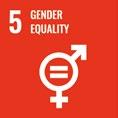


69
The Seeberger community
Seeberger is growing. We have developed new custo mer groups and business areas over the last few years thanks to company acquisitions. And gained many new colleagues. An enrichment, as it brings exciting impetus and ideas for our common working life. And this com mon working life is working very well.
Yet there are some issues that just take time. These are very practical or structural tasks: we are desig ning more standardised salary structures and working conditions. How are we integrating IT systems? Just as important: how do we find common values and a
common corporate culture? How we work together as a growing, diverse and agile community is a process that we are shaping together.
A process, however, which has had to tolerate a lot over the last two years because of changing Covid rules and health and safety regulations. What can we take away from this time? A lot of good too, because Covid led to a renewed push for digitisation and modernisation. And to a re-evaluation of issues like flexible and mobile working.
THE SEEBERGER GROUP
SEEBERGER GMBH
Healthy, natural snacks
Target group: retailers and end consumers
SEEBERGER PROFESSIONAL GMBH
Coffee, tea
Target group: catering industry & corporate customers
› Many acquisitions over the last 5 years
SEEBERGER GENUSSWELT GMBH
Shop, café, experience, conference rooms, events, employee restaurant
70
>>> INTRO OUR FOUR ACTION FIELDS > COMMUNITY
Management expertise was (and will continue to be) expanded with workshops.
STRENGTHEN OUR BINDING CORPORATE CULTURE AND VALUES
Concept for the compatibility of work and caring. The services are part of our “Seeberger Family” employee programme.
Our Compliance Management System was expanded to include corruption and whistle-blowing.
Code of Conduct: current version being reviewed for the new Seeberger structure including company acquisitions.
30 percent of PEP@SB-TN have taken on advanced roles. A further 50 percent of them have expanded their area of responsibi lity within their existing role/position.
CREATE ATTRACTIVE WORK ENVIRONMENTS
“Business Team” organisation introduced. All Seeberger divisions have a Business Team. Business Team members are available as perma nent points of contact for all departments for their issues and projects. They tackle them in their de partments, coordinate or allocate tasks. Business Team members meet regularly and discuss the latest issues on an inter disciplinary basis.
Certification of the Compliance Management System: two of the three stages of the certification process have been com pleted. The third stage is being implemented now.
71
2019 2020 2020 2021
What have we achieved so far?
72 Employee fluctuation Working at Seeberger in numbers 10 8 6 4 2 0 2014 2015 2016 2017 2018 2019 2020 2021* *Data situation: by 2020 Seeberger GmbH, from 2021 Seeberger Group Fluctuation total without natural fluctuation 9.6 % 7.6 % 6.9 % 6.1 % 8.5 % 7.1 % 9.7 % 8.4 % 7.2 % 6.5 % 6.3 % 5.6 % 10.6% 8.7 % NUMBER OF NATIONALITIES 36 MEN IN TOTAL 53 % AVERAGE AGE 41 ILLNESS RATE FOR THE SEEBERGER GROUP 2021 6 % with an average of 250 working days per year ILLNESS RATE PER EMPLOYEE ON AVERAGE 15.12 days per year (6 % of 250 working days) WOMEN IN TOTAL 47 % WOMEN ON EXECUTIVE BOARD 0 % FEMALE TEAM LEADERS 32 % FEMALE DEPARTMENT HEADS 25 % WOMEN AT 1ST REPORTING LEVEL 25 % WOMEN IN SPECIALIST ROLES WITH HIGH RESPONSIBILITY e.g. marketing managers, KAM etc. 56 % 6.5 % 5.0 % OUR FOUR ACTION FIELDS > COMMUNITY
FULL-TIME 500 PART-TIME 16 TOTAL 516
FULL-TIME 252 PART-TIME 106 TOTAL 358
PERMANENT 473 TEMPORARY 34 TRAINEES 25 TOTAL 532
PERMANENT 304 TEMPORARY 25 TRAINEES 13 TOTAL 342
FULL-TIME 507 PART-TIME 15 TOTAL 522
FULL-TIME 257 PART-TIME 118 TOTAL 375
EMPLOYEES IN TOTAL IN 2020: 874
PERMANENT 487 TEMPORARY 36 TRAINEES 25 TOTAL 548
PERMANENT 305 TEMPORARY 32 TRAINEES 12 TOTAL 349
EMPLOYEES IN TOTAL IN 2021: 897
73
2020
2021
Employees at Seeberger
Our goals by 2025
1STRENGTHEN OUR BINDING CORPORATE CULTURE AND VALUES
Establish the “ONE SEEBERGER” project to strengthen our sense of community. Project goal: expand the “Seeberger Family” employee programme across the whole Seeberger Group
Establish a uniform management culture for the whole Seeberger Group
Expand and adapt employee participation across the whole Seeberger Group
Encourage and require achievement, in order to be successful together
74
2
CREATE ATTRACTIVE WORK ENVIRONMENTS
Our
strategy
VISION
➔ WE WANT TO BE AN ATTRACTIVE AND SOUGHT-AFTER PARTNER
HOW DO WE DO THAT?
1
STRENGTHEN OUR BINDING CORPORATE CULTURE AND VALUES
OUR FOUR ACTION FIELDS > COMMUNITY
Seeberger Corporate Values
QUALITY
RELIABILITY FAIRNESS SUSTAINABILITY
Our approach
For generations our company has been growing with just one raw material: natural products. Our company’s success would not be possible without optimal growing conditions in source countries and the high dedication
of our employees and suppliers worldwide. We are re sponsible for that. Our corporate values ensure it. For generations they have determined who we are today and who we will be in the future.
The Seeberger Group: community in flux
Our corporate structure has become much more diverse over the last two to five years due to company acquisitions. The companies of the Seeberger Group differ in more ways than their organisational structure, however. Basic working conditions such as pay, working
A common management culture
Good management is a success factor. A common un derstanding of management – no simple task. Because of this, we have created a standardised management programme for all the companies of the Seeberger Group. Under this programme we are training and strengthening the management expertise of our ma nagers individually and collectively.
hours, number of annual leave days or benefits, are also very different. In 2022 we are analysing the current per formance structures of the Seeberger companies. We can then use the results to prioritise coordination tasks and devise appropriate measures together.
In addition to our programme, we train managers as needed too. We also support them day to day: a team of Business Partners work in our Human Resources department, who provide managers with departmentspecific advice on important decisions and manage ment issues.
75
Seeberger employee participation

We involve employees in shaping our company – and in its success. Thanks to our two employee participation schemes, each year they receive a profit-based bonus and an attractive, profit-based rate of interest on their share of the company’s capital. This investment and the
interest on the capital support long-term wealth buil ding. Our goal is to expand our employee participation across the entire Group in future on the basis of con solidated annual accounts, but nevertheless taking the performance of the respective company into account.
Employees
TURNOVER PROFIT PROFIT-SHARING
PARTICIPATION RIGHT EMPLOYEE CREDIT
›› Annual payout
›› Some is paid out and some is paid into a participation account to accumulate interest = wealth building (tied up for 6 years)
›› Additional profit-sharing for employees over the age of 40 who have been with the company for at least 10 years
›› Not accessible until retirement, then paid out in 10 annual instalments
Seeberger Family: we are all “Seebergerites”
We are a family company: for us, this includes treating each other with appreciation and respect. And a good work-life balance. To achieve this, we offer our emp loyees extensive additional benefits within our “See berger Family” employee programme. In addition to services that help to reduce or eliminate stress like nur sery places, sport and massages, we also encourage the Seeberger team spirit through a wide range of activities.
And we want to do this at all locations. Our “EIN SEE BERGER” project will therefore make the benefits of Seeberger Family available to all employees in future, independent of the Ulm location. We’ve made a start: our “JobBike” service is now available throughout Ger many. We are currently working to expand our range of sports, the “care pilots” and the employee discount for the Seeberger online shop.
76
generate this minus costs and investments = = calculation basis for
OUR FOUR ACTION FIELDS > COMMUNITY
We would really have liked to open our “Seeberger Genusswelt” with a bang as an overall pleasure concept. Covid has also caused a lot of delays here unfortunately. But postponed does not mean abandoned: the bang is coming in 2022 with a summer party for the large Seeberger community.




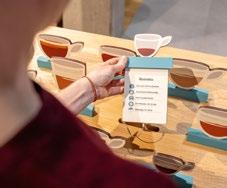



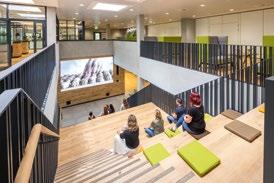
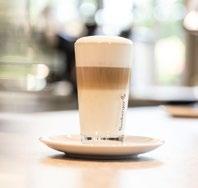


77
SHOWCASE OF THE SEEBERGER GROUP Since January 2021 GENUSS MARKT BARISTA COURSES EVENT SPACE & CONFERENCE ROOMS FOR HIRE EXPERIENCE Since June 2021 CAFÉ Since autumn 2021 EMPLOYEE RESTAURANT PLATFORM FOR ALL BUSINESS DIVISIONS FOR EMPLOYEES AND CUSTOMERS COMMUNITY SPACE MEETING PLACE Since the end of 2020 OFFICES SHOW KITCHEN LIVE COFFEE ROASTING A Genusswelt for all
CREATE ATTRACTIVE WORK ENVIRONMENTS
HOW DO WE DO THAT?
Our goals by 2025
Devise and adopt the “Mobile Working” company agreement
Establish a transparent and motivating salary structure
Establish the “New Work” working group to focus on networking and cooperation
“Mobile Working” company agreement
During the pandemic, mobile working became an integral part of our working world. We have since learned to combine the advantages of mobile working with those of the classic office life. There’s more: the framework conditions and a legal basis will be created for this by
2025 with a new “Mobile Working” company agree ment. In our eventful working lives we find that: the right mix is what counts and we have to find the best way to combine the different ways of working.
Transparent and motivating salary structure
“Operating the teletypewriter”. That’s a job descrip tion, by way of example, from the salary grading plan for wholesale and foreign trade in Baden-Württemberg from 1995. As a company bound by collective bargai ning agreements, this is what Seeberger uses to clas sify its employees. Because outdated tasks like these don’t fit with our job profiles and only a fraction of our tasks and competencies are covered by this plan, the
Works Council and Human Resources department have started the “Classification Re-Evaluation” project. Toge ther with section heads from the departments, they are creating new job clusters with up-to-date, appropriate job descriptions. They will then use the new clusters to find a joint solution for appropriate re-evaluation and classification.
78
2
OUR FOUR ACTION FIELDS > COMMUNITY
“New Work” working group
Naturally, “New Work” is also a current issue in a family company with more than 175 years of tradition. The Covid crisis has massively accelerated the digitisation of our working areas – this supports modern working structures. New Work means more than digitisation or reorganising though. We also want participative structures and greater individual responsibility for em ployees. We know there are a lot of people working
for us who are ready to try something new. Our new project group “New Work” is working on opening up our working structures for greater active participation. After all, don’t the best ideas for the community come from the community? The “New Work” project group is currently focussed on the issues of internal networking and communication for more cooperation and less “silo thinking”.
A long-term success story: awards and initiatives
Talking of “New Work”: in 2020 and 2021 we were once again presented with the “Employer Branding Award” by the University of Applied Sciences Neu-Ulm (HNU). The award is the result of the Employer Branding Study: around 1,000 students from the Universities of Applied Sciences in Neu-Ulm and Ulm, the Ulm School of Com munication and Design and Ulm University were asked about recognition, appeal, readiness to apply and likeability of the best-performing companies with at least 500 employees in the region.

The result: Seeberger is one of the top 3 employers. In the ‘Likeability’ category we are even number one. Per haps that’s also down to the creative video clips posted by our trainees on the new Seeberger TikTok channel (@seeberger_de). Our employee initiatives “Seeberger Ideas Workshop” and “Nature Ambassadors” also want to shape the community. Every year they realise nume rous sustainability and efficiency projects in working life.

79
AWARD: TOP EMPLOYER IN THE REGION “EMPLOYER BRANDING AWARD”, 2020/2021: 3RD PLACE
Organisational profile
102-1 Name of the organisation
Seeberger Group
102-2 Activities, brands, products and services 11 Our company, corporate figures
102-3 Location of headquarters
Hans-Lorenser-Straße 36, 89079 Ulm
102-4 Location of operations Headquarters in Germany. Sales offices in China (Shanghai), France (Paris) and the Baltic States (Riga).
102-5 Ownership and legal form
The parent company owns 100 % of the Seeberger companies and is family-owned
102-6 Markets served 11 Our company, Seeberger markets
102-7 Scale of the organisation 11 Our company
Total number of business locations: main location / Seeberger GmbH: Hans-Lorenser-Str. 36, Ulm Seeberger Professional, Klein-Kollenburg-Straße 42, 47877 Willich Seeberger GenussWelt GmbH, Hans-Lorenser-Str. 20, 89079 Ulm
Total capital: no details on total capitalisation No details on volume of supplied products and services for competitive reasons.
102-8 Information on employees 72&73 Community, working at Seeberger in numbers
102-9 Organisational supply chain 40 ff. Supply chain responsibility
102-10 Significant changes to the organisation and its supply chain Genusswelt opening 2021
102-11 Precautionary principle or approach Seeberger quality audits and certifications 102-12 External initiatives
Internationally recognised standards are used for reporting, such as the Greenhouse Gas Protocol and the Guidelines of the Global Reporting Initiative. We have participated in the Global Compact since 2015, the UN global initiative for responsible business management.
Involvement in the sustainability field: BioVal research project and HolyGrail Initiative
102-13 Membership of associations Main membershipsin which Seeberger holds a position on the governance body, participates in projects or committees, or views its membership as strategic:
- Food Federation Germany (Bund für Lebensmittelrecht und Lebensmittelkunde e.V.)
- Ulm Chamber of Industry and Commerce (IHK)
- Association for quality products from Baden-Württemberg (Fördergemeinschaft B-W)
- Hamburg import trade association (Waren-Verein)
- SA2 GS1 Germany
- Federation of German Wholesale, Foreign Trade and Services (BGA)
- German association of family businesses (ASU)
- German Association for Employee Participation (AGP)
- BDSI Bundesverband der deutschen Sußwarenindustrie e.V. and German Sweets
Strategy
102-14 Statement from a senior decision-maker 6&7 Foreword
Ethics and integrity
102-16 Values, principles, standards, and norms of behaviour 12 ff. NaturWelt – our sustainability strategy
Governance
102-18 Governance structure
Stakeholder engagement
4 Managing Directors (Clemens Keller: responsible for Production and Administration, Ralph Beranek: responsible for Goods Management, Raphael Steinberg: responsible for Seeberger Professional, Gerald Lindinger: responsible for Finances and IT)
Sustainability has been firmly established in the corporate goals since 2015. Sustainability department since 2022
102-40 List of stakeholder groups 14 Our stakeholders 102-42 Identifying and selecting stakeholders
The basis for identifying and selecting stakeholders has not changed. It is described in the Sustainability Report 2013. 102-43 Approach to stakeholder engagement The approach to stakeholder engagement has not changed. It is described in the Sustainability Report 2013. 102-44 Key issues and concerns raised 15 Materiality Matrix
Reporting practice
102-45 Entities included in the consolidated financial statements
The reporting includes the main location in Ulm and all subsidiaries registered in Germany. 102-46 Defining report content and issue boundaries NaturWelt – our sustainability strategy 102-47 List of material issues Our four focus themes 102-48 Restatements of information 12 ff. NaturWelt – our sustainability strategy 102-49 Changes in reporting 15 ff. Continuation of the materiality process see Materiality Matrix 102-50 Reporting period 12 ff. 01/01/2020 to 31/12/2021 102-51 Date of most recent report 15 December 2020 102-52 Reporting cycle Every 2 years 102-53 Contact point for questions regarding the report Verena Schädler, Sustainability Officer, naturwelt@seeberger.de 102-54
80 GRI NO. GRI SHORT DESCRIPTION PAGE CONTENT,
GRI 102 – GENERAL
NOTES AND ADDITIONS
DISCLOSURES
with the
External assurance
GRI 103 MANAGEMENT
103-1-3 Explanation of the material issue and its boundary 16&17 Our four action fields GRI 200 ECONOMIC
Direct economic value generated and distributed 10 Business figures 205-1 Operations assessed for risks related to corruption All 205-2 Communication and training about anti-corruption policies and procedures As part of the Compliance Management System 205-3 Confirmed incidents of corruption and actions taken None 206-1 Legal actions for anti-competitive behaviour, anti-trust, and monopoly practices None GRI 300
Materials used by weight or volume No data available
Energy consumption within the organisation 63 See
footprint
Energy intensity 63 See
Claims of reporting in accordance
GRI Standards ‘This report has been prepared in accordance with the GRI Standards: Core option’. 102-56
External creation of climate footprint, without creation of test report
APPROACH
201-1
ENVIRONMENTAL Materials 301-1
Energy 302-1
climate
302-3
climate footprint
Energy
302-4 Reduction of energy consumption 62 ff. See climate footprint
302-5 Reductions in energy requirements of products and services 62 ff. See climate footprint
Water and effluents
303-1
Protected areas
Water withdrawal and consumption: 100 % from municipal network; no withdrawal of infiltration water, no water treatment or use of grey water
304-1 Operational sites owned, leased, managed in, or adjacent to None
Emissions
305-1 Direct (Scope 1) GHG emissions 63 See climate footprint
305-2 Energy indirect (Scope 2) GHG emissions 63 See climate footprint
305-3 Other indirect (Scope 3) GHG emissions 63 See climate footprint
305-4 GHG emissions intensity 62 ff. See climate footprint
305-5 Reduction of GHG emissions 62 ff. See climate footprint
Waste
306-2 Waste by type and disposal method 18 ff. Focus issue circular economy
306-3 Significant spills None
306-4 Transport of hazardous waste None
Environmental compliance
307-1 Non-compliance with environmental laws and regulations
Supplier environmental assessment
No fines were imposed for non-compliance with environmental laws and regulations
308-1 Percentage of new suppliers that were screened using environmental criteria 100 %
308-2 Negative environmental impacts in the supply chain and actions taken 40 ff. See supply chain responsibility: Seeberger monitoring cycle
GRI 400 SOCIAL
Profession
401-1 New employee hires and employee turnover 72&73 Community: working at Seeberger in numbers
401-2 Benefits provided to full-time employees that are not provided to temporary or part-time employees Company benefits are also provided to part-time employees
Labour/management relations
402-1 Minimum notice periods regarding operational changes
Occupational health and safety
403-1 Occupational health and safety management system
As needed in acc. with the German Works Constitution Act (BetrVG)
ASA occupational safety committee comprising 16 (2021) people from Works Council, Technology, Operations and Building Services Management, internal safety officer, external safety expert, company doctor). Seeberger Family health services
403-3 Occupational health services Company doctor
403-4 Worker participation, consultation, and communication on occupational health and safety Works Council and ASA (occupational safety committee) and occupational safety officer (external)
403-5 Worker training on occupational health and safety
Conducted regularly
403-6 Promotion of worker health “Seeberger Family” employee programme
403-9 Work-related injuries No deaths
403-10 Work-related ill health No work-related illnesses
Education and training
404-2 Programmes for upgrading employee skills
Diversity and equal opportunity
405-1 Diversity of governance bodies and employees
405-2 Ratio of basic salary and remuneration of women to men
Non-discrimination
Training on the job, development programme PEP@Seeberger, training in seminars and workshops
72 Current status of women on Executive Board: 0 %, 1st management level: 25 %; department heads: 25 %, team leaders: 35 %; specialist roles with high responsibility: 56 %
72 Basic salary and additional pay above the collectively agreed scale are dependent on employee category, role and number of years with company. Men and women are treated equally.
406-1 Incidents of discrimination and corrective actions taken None
Freedom of association and collective bargaining
407-1 Operations and suppliers in which the right to freedom of association and collective bargaining may be at risk
Child and forced labour
408-1 Operations and suppliers at significant risk for incidents of child labour
409-1 Operations and suppliers at significant risk for incidents of forced or compulsory labour
Human rights
Is questioned as part of supplier monitoring and checked during local visits
Is questioned as part of supplier monitoring and checked during local visits
Is questioned as part of supplier monitoring and checked during local visits
412-1 Operations that have been subject to human rights reviews or impact assessments None
Supplier social assessment
414-1 New suppliers that were screened using social criteria 100 %
414-2 Negative social impacts in the supply chain and actions taken
Political influence
Supplier monitoring, development of sustainability index for food suppliers
415-1 Political contributions None
Customer health and safety
416-2 Incidents of non-compliance concerning the health and safety impacts of products and services None
417-2 Incidents of non-compliance concerning product and service information and labelling None
418-1 Substantiated complaints concerning breaches of customer privacy and losses of customer data None
Socioeconomic compliance
419-1 Non-compliance with laws and regulations in the social and economic area None
81 GRI NO. GRI SHORT DESCRIPTION PAGE CONTENT,
GRI 300 ENVIRONMENTAL
NOTES AND ADDITIONS
CONTACT
I welcome your thoughts and a constructive dialogue. You can contact me directly by email at:
NATURWELT@SEEBERGER.DE
LEGAL NOTICE
Publisher: Seeberger GmbH Hans-Lorenser-Straße 36 D-89079 Ulm
Tel.: +49 (0)731 4093-0 Email: info@seeberger.de www.seeberger-gruppe.de Email: naturwelt@seeberger.de
Editors: Verena Schädler, Seyda Keles, Sabine Jörg, Bettina Stein Layout: Hanschur Gestaltung
The cover for this Sustainability Report was printed on FSC-certified Crush paper from Römerturm. The paper contains elements from the almond harvest. Almonds are processed for food and cosmetics production after harvesting. The by-products are ground to a fine powder and creatively processed into the sustainable and eco-friendly Crush paper.
Up to 15 % almond paper 40 % recycled paper Remainder virgin cellulose 100 % production with green energy
The paper for the report’s internal pages is made from 100 % recycled paper and is FSC and Blauer Engel certified.
This report used climate-neutral printing with Climate Partner.

82
VERENA SCHÄDLER SEEBERGER SUSTAINABILITY OFFICER
CONTACT & LEGAL NOTICE
83
Seeberger GmbH · Hans-Lorenser-Straße 36 · D-89079 Ulm · www.seeberger-gruppe.de













































































































